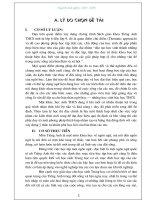PHƯƠNG PHÁP DẠY HỌC MÔN TIẾNG ANH
Bạn đang xem bản rút gọn của tài liệu. Xem và tải ngay bản đầy đủ của tài liệu tại đây (405.23 KB, 17 trang )
TESTING
I. Questions for
discussion
II. Design a 15 – minute
test or 45 – minute test
with key answers
QUESTIONS FOR DISCUSSION
1. Why and what should teachers give tests to
students ?
2. State what you know about innovation / change
in testing.
3. List some test types you usually give your
students.
4. Suggest what should be done to make fair tests.
1.Why and what should teachers give tests
to students ?
Regular tests play an important role
because
1.The tests tell the teacher :
* What the students can and cannot do
* How successful the teaching has been
* What areas need to be taught in the
future
2. The tests tell the students :
* How well they are progressing
* Where they need to focus their
attention as learners
* Regular tests also encourage
students to take their learning
seriously, and give them a series of
definite goals to aim towards. In sum,
* A class test enables the teacher to
increase his own effectiveness.
3. A good classroom test helps
* locate the areas of difficulty encountered by the
class or the individual students.
* enable the teacher to diagnose his students
weaknesses or difficulties, and ascertain the
difficulty that lie in any part of the language
programme.
* provides the students with an opportunity to
recognize and produce correct forms of the
language and be able to learn from their errors and
consolidate the pattern after the test.
What should teachers test?
In testing language, teachers should test :
1.
2.
Linguistic elements (grammar, vocabulary, spelling,
pronunciation) to find out what students have learnt
Language skills (listening, reading, speaking, writing) to find
out what students can do.
A. Testing receptive skills
B. Testing speaking (oral test)
C. Testing writing
D. Testing vocabulary
E. Testing grammar
F. Testing pronunciation
2. Innovation/Change in Testing
In traditional language teaching, formal and informal tests are given to
students by their teachers.
Nowadays, based on student-centered approach, language testing
includes tests, continuous/continual assessments.
- Formal tests : at the end of a semester/ school year, marked, and
assessed by teachers.
- Continuous/continual assessments: during the course, students are
assessed by teachers( teacher assessment), or classmates (peer
assessment), or the student himself/herself (self-assessment).
3.Some test types
a)
b)
c)
Teachers might use a variety of test
types which will depend on
The level of students
The skills they want to test
The language points they want to test
A.
Listening tests
1.
2.
3.
4.
5.
Multiple choice
True-False
Open-ended questions
Grid-filling
Gap-filling (cloze)
B. Reading tests
1. Multiple choice
2. True-False
3. Open-ended questions
4. Grid-filling
5. Gap-filling
C. Speaking tests
1. Prompts/Picture prompts
2. Asking and answering questions
3. A set of topics
D. Writing tests
Guided writing tests:
- Gap-filling
- Re-ordering words
- Summary writing based on texts
Free writing tests:
- Sentence writing
- Paragraph writing
- Essay writing
4.Some suggestions for making
fair tests
Ask enough questions to test
accurately.
Write clear instructions/directions for
the test and use examples.
Test what has been taught in class.
Write clear test items.
Compare the following:
Item 1: Directions: Choose the best
response.
Today it is rather cloudy.
A. It will probably rain.
B. Yesterday the weather was
nice.
C. Yes, I think so, too.
Item 2: Directions: Choose the letter for the
answer which means the same as the statement.
Today it is rather cloudy.
A. The clouds are dark.
B. It is not too sunny today.
C. It might snow tomorrow.
Which item is clear?
Item 2 is clear; Item 1 is unclear.
When writing multiple choice questions, use
realistic distractors.
Distractors are wrong answers. A test will not be reliable
if impossible distractors are used.
Consider the following question:
What color is the sun?
A. Yellow ( This is intended correct answer)
B. Orange ( too close to the correct answer)
C. Soft (not a color & too far from the correct answer)
D. Yes (It is a bad distractor because this is an answer
to a yes/no question)
A better set of answers to test knowledge of
colors would simply be a list of colors:
A. blue
B. green
C. yellow
D. black
Score tests consistently with a key.
When scoring, use a key that will help
teachers grade objectively. The key should
have examples of correct answers ( though
other correct answers should be accepted)
and the appropriate points/marks as well.
Avoid traps for students
A good test should never be constructed in
such a way as to trap the students (testees)
into giving an incorrect answer. All tests
should be constructed primarily with the
intention of finding out what a student
knows _ not with trapping him.
II. Design:
15 –minute test
45 –minute test
(with key answers)









